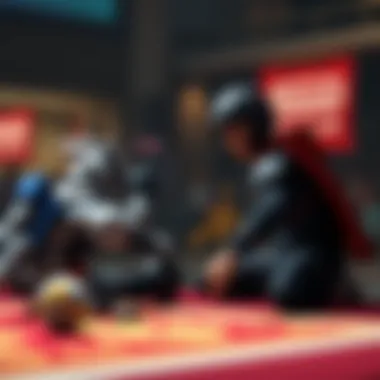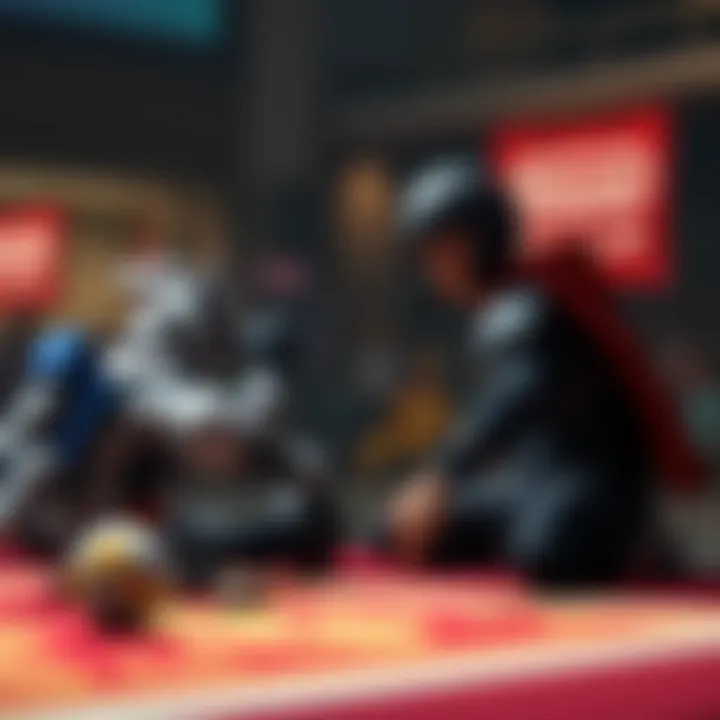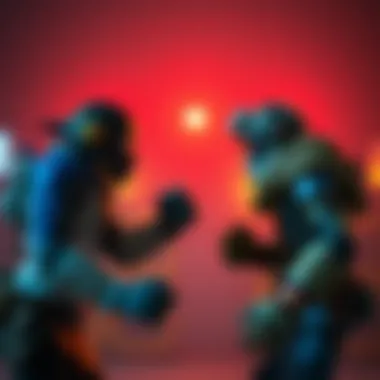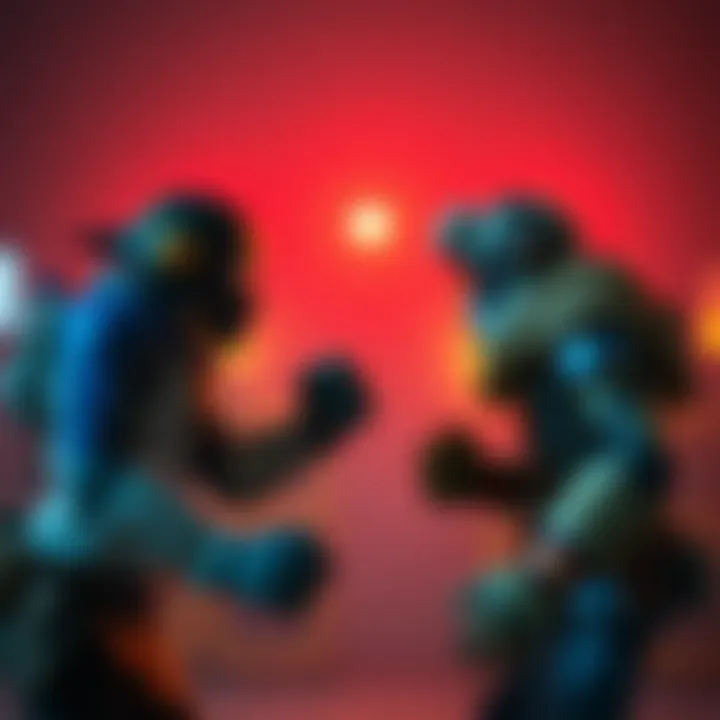The Intricacies of One-on-One Gaming Dynamics


Intro
One-on-one games have a certain flair that sets them apart from the more common multiplayer experience. Each player finds themselves in a direct clash of wits, reflexes, and tactics. Whether it's the mental chess match of a fighting game or the strategic maneuvers in a sports simulation, these contests are not just bouts of skill but also tests of psychological resilience.
Players engage in a tight dance, where each move can lead to victory or mishap. The thrill of direct competition lays the foundation for an experience that often melds personal skill development with strategic insight. We embark on a journey to dissect the elements that not only make these games engaging but also influential in shaping the broader landscape of gaming culture.
Game Reviews
Overview
The beauty of one-on-one games is their innate simplicity juxtaposed with deep complexity. Titles such as Street Fighter and NBA 2K may seem straightforward, yet they each harbor layers of gameplay mechanics and strategies beneath the surface. This section aims to draw attention to various standout games that have carved their niche over the years.
Gameplay
In one-on-one games, the gameplay mechanics often define the experience. With titles like Mortal Kombat, intricate move sets and combo sequences come into play, keeping players engaged. Each character has strengths and weaknesses, altering strategies as players adapt to their opponent's style.
Storyline
While many consider the storyline of one-on-one games secondary to gameplay, it's remarkable how narratives can enhance the overall experience. Take, for instance, Tekken, where character backstories intertwine with their conflict. This depth is what keeps fans coming back, seeking to understand the motivations of their favorite fighters.
Graphics
Visually striking graphics bolster the immersive quality of one-on-one games. Titles such as Smash Bros. have evolved significantly. From simplistic sprites to rich, textured environments, the visuals play a pivotal role in captivating players and adding layers to the competitive action.
Soundtrack
Music often becomes the heartbeat of a game. In one-on-one gaming, a riveting soundtrack can create an electric atmosphere that enhances tension and excitement. Games like Mortal Kombat, with their iconic themes, turn confrontations into epic showdowns.
Pros & Cons
When evaluating the essence of one-on-one games, several advantages and disadvantages come forth:
- Pros:
- Cons:
- Direct competition fosters skill growth.
- Enables deeper strategic engagement.
- Typically easier to learn, harder to master.
- May become repetitive without fresh updates.
- High skill disparity can discourage new players.
Final Verdict
To conclude, one-on-one games hold a mirror to the very heart of competitive spirit in gaming. From building player skills to creating lasting impressions in gaming culture, their impact is undeniable. By examining various games through these lenses, gamers can cultivate a richer understanding of what it means to engage competitively, be it casually with friends or in high-stakes tournaments.
Historical Overview of One-on-One Games
One-on-one games have an intricate backstory that shapes their experience today. Understanding the historical development of these games not only enhances appreciation for their artistry but also sheds light on fundamental elements that have persevered through time. As players engage in these games, they participate in a tradition that has evolved and influenced countless facets of culture. The evolution of one-on-one gameplay reveals shifts in societal norms, technological advancements, and the psychological drivers behind competition.
As we delve into the origins of one-on-one gameplay, the focus will be on how such interactions have existed in various forms since ancient times—whether as informal competitions in local communities or officially sanctioned contests with specific rules. The importance of recognizing these roots lies in grasping how the mechanics and strategies have transformed, ultimately affecting player engagement and community dynamics.
Origins of One-on-One Gameplay
The roots of one-on-one competition can be traced back to various ancient cultures. For example, in Ancient Greece, sports such as wrestling and boxing were both forms of competition and avenues for establishing social status. These games weren’t merely about physical prowess; they were deeply intertwined with community values, honor, and tradition.
Fighting for glory, these early competitors would face off in front of spectators who often dictated the course of the match with their cheers or jeers. This social component lent a vibrant energy to competitions that persists in modern gaming.
Similarly, historical board games, like Chess, which is believed to have originated from Chaturanga in India around the 6th century, serve as another pivotal aspect of one-on-one gameplay history. Here, strategy and foresight come into play, as the goal remains to outwit the opponent on an intricate battlefield. Through war simulations reflected in these games, people learned valuable lessons on tactics, planning, and foresight that transcend mere entertainment.
In essence, one-on-one games emerged not just as a pastime but as cultural phenomena that signify individual skill and communal engagement.
Evolution Through the Decades
The evolution of one-on-one games can best be described as a tapestry of technological and cultural shifts spanning centuries. In the late 19th century, competitive card games gained popularity, establishing a new avenue for social interaction through head-to-head play. The introduction of standardized rules meant that people could engage in competitive mindset while still enjoying camaraderie in their local taverns.


As the 20th century approached, various sports began to be organized under strict regulations. Chess became recognized internationally, with competitions attracting global talent. This was a massive shift in how these games were perceived; from being mere duels of skill to prestigious events worthy of respect.
Moving into the late 20th century and the advent of video games, the landscape shifted substantially yet again. Games like Street Fighter and Mortal Kombat took the one-on-one duel to a new dimension by incorporating technology, graphics, and multiplayer interfaces. These innovations added layers of complexity to strategy and tactics, echoing the traditions of old while embracing the new.
Today, online platforms have further transformed the dynamics, allowing players from different continents to engage in direct competition as if they were face to face. The historical timeline of one-on-one games showcases a constant evolution characterized by cultural shifts, technological innovations, and the unyielding desire for personal competition. This, in turn, enhances both individual and community experiences by weaving them into the larger fabric of gaming history.
Core Dynamics in One-on-One Games
Understanding the core dynamics in one-on-one games goes beyond merely recognizing their competitive nature; it involves grasping the intricate interplay between mechanics, strategy, and player behavior. These dynamics form the backbone of engagement and challenge, making them essential for players who seek to improve their skills and foster a deeper appreciation for gaming.
At its heart, one-on-one gaming creates a focused arena where players face off, testing their skills directly against one another. This scenario naturally cultivates a visceral sense of rivalry which can ignite intense passion. Consequently, players often find themselves deeply invested not just in the outcome of the match but in the nuances of their opponent's tactics. Understanding these dynamics aids in developing a keen awareness of not just one’s own strengths and weaknesses, but also recognizing those of one’s adversary.
Moreover, the importance of honing game mechanics and strategic thinking cannot be overstated. Players who grasp these elements tend to gain a competitive edge. They learn to exploit game mechanics to their advantage while simultaneously adapting their strategies to counteract their opponent’s moves.
Game Mechanics Explained
Game mechanics are the building blocks that define how a game operates. They encompass everything from basic rules to complex systems that govern player movement, scoring, and interaction. In one-on-one games, these mechanics can significantly influence the outcome of a match.
For instance, in a fighting game like Street Fighter V, players must navigate a variety of moves, combos, and character traits to gain the upper hand. These mechanics dictate the pace of gameplay, establishing a rhythm that players must adapt to. Knowing how to execute specific moves at precise moments can mean the difference between victory and defeat. This highlights the need for muscle memory—a skill developed through repeated practice and familiarity with the game mechanics.
The underlying mechanics can also vary greatly depending on the genre. In games like chess, the mechanics are strategic, requiring players to think several moves ahead and anticipate their opponent's responses. On a contrasting note, sports simulations such as FIFA 21 rely on a blend of physics-based movement and digital representation of real-life strategies. Understanding these mechanics lays the groundwork for skill development.
The Role of Strategy
Strategy is the art of making informed decisions based on the mechanics at play. It is the mental chess match that occurs alongside the physical movements during competitive gameplay. A savvy player not only understands the mechanics but can also implement various strategies within that framework to outsmart their opponent.
In one-on-one scenarios, strategies can take many forms—from aggressive techniques that rely on overpowering the opponent to passive ones that focus on defense and waiting for the right opportunity to strike. This duality shows the depth of strategic thought required in one-on-one games. The most successful players can pivot between these strategies fluidly, adapting to new situations as they arise.
Players can also harness psychological tactics, such as feints or bluffs, to manipulate their opponents’ expectations. This mental aspect often distinguishes average players from the elite, underscoring the importance of both mental acuity and physical skill.
"In one-on-one games, the mind is as much a weapon as any sword or fist. Strategy blends wit with skill, creating an art form worthy of deep study."
In summary, the core dynamics of one-on-one games revolve around grasping intricate game mechanics and mastering strategic thought processes. Together, they empower players to elevate their gameplay, turning challenges into opportunities for growth and improvement.
Genres of One-on-One Games
One-on-one games are diverse, covering various genres that cater to different tastes and preferences. The importance of understanding these genres lies in their unique characteristics, which influence gameplay, player interaction, and enjoyment. From fighting games to classic strategy games like chess, each genre presents specific elements that enhance skills, foster competition, and create distinct social dynamics. Examining these genres not only highlights their individuality but also unravels the broader implications they have on gaming culture and the skills players develop through engaging with them.
Fighting Games
Fighting games form a cornerstone of one-on-one gaming, offering intense, skill-based showdowns between players. Titles like Street Fighter and Tekken showcase this genre’s appeal, characterized by their combination of fast-paced action and deep mechanics. Players choose from a diverse roster of characters, each with unique move sets, strengths, and weaknesses, making character selection pivotal. The heart of fighting games lies in the combat mechanics, which often involve combos, special moves, and timing.
Effective decision-making and strategic planning are essential, as players not only focus on their attacks but also predict and react to their opponent’s moves. A noteworthy aspect of fighting games is the community that often surrounds them. Tournaments, such as EVO (Evolution Championship Series), elevate the competitive scene, creating rivalries and camaraderie among players. This genre not only sharpens technical skills but also cultivates an environment rich in social interaction and collective enthusiasm for competition.
"Fighting games push players to the limit, where skill is king and innovation in tactics reigns supreme."
Chess and Board Games
Chess and various board games represent a different facet of one-on-one gaming where intellectual prowess takes center stage. Unlike the adrenaline-fueled dynamics of fighting games, the chessboard is a battlefield of the mind. In chess, each piece carries its own weight, contributing to a strategic framework where thinking several moves ahead is mandatory. The allure of chess lies in its depth—widely studied openings, endgames, and tactics invite players to explore countless strategies.
Other board games, such as Go, and even contemporary variations like Duelyst, also fit into this genre, emphasizing strategic planning and foresight. In these games, victory often hinges more on mental agility than physical reflexes, allowing them to appeal to a broad audience. Chess has also achieved notable recognition in pop culture, further influencing youth through movies, books, and even online streaming, showcasing its capacity to blend competition with intellectual engagement.
Sports Simulations
The realm of sports simulations introduces a more visceral feel to one-on-one competition. Games like FIFA and NBA 2K simulate real-life sports, allowing players to engage in head-to-head matches that mirror their favorite teams. These games capture the essence of athletic competition while offering a unique gaming experience that emphasizes both strategic positioning and real-time skill execution.
Sports simulations not only replicate the thrill of competition but also challenge players on various fronts—team management strategies, perfecting playing styles, and executing complex moves within tight timelines. By capturing the nuances of real-world sports, they tend to attract both hardcore sports enthusiasts and casual gamers, bridging gaps between different interests and fostering a vibrant community centered on sports culture.
In summary, genres of one-on-one games are characterized by their unique gameplay mechanics, strategies, and social interactions. Whether through the martial displays of fighting games, the cerebral battles of chess, or the adrenaline rush of sports simulations, these genres contribute immensely to the richness of the gaming landscape, influencing how players develop their skills and engage with one another.
Skill Development Through One-on-One Games


One-on-one games are more than just a platform for conflict or competition; they pave the way for significant skill development in players. Engaging in these games allows individuals to hone a variety of skills that can be applied in both gaming and real-world contexts. As we explore this section, we will delve into the specific cognitive enhancements and the physical intricacies that these games foster.
Cognitive Skills Enhancement
At the heart of one-on-one games lies a fierce mental battleground. Players are constantly required to assess not only their moves but also their opponent's tactics. This demands a high level of cognitive processing. Players engage in critical thinking and strategic planning, often improvising or adapting their strategies mid-game. These elements not only sharpen decision-making skills but also enhance problem-solving abilities.
For instance, consider chess: a game steeped in tradition that involves anticipating an opponent's moves while formulating a plan of attack. These cognitive demands correlate strongly to enhanced performance in academic pursuits as well. Research indicates that activities requiring deep focus—like chess—improve memory and boost overall brain function. One might argue that the benefits extend beyond the board or arena, as players learn to transfer these enhanced cognitive abilities into their everyday lives.
"Playing some of these intense one-on-one games is like running a mental marathon—each move feeds into your next strategies, enhancing your ability to think quickly and critically.”
Indeed, this enhanced central processing can translate to improved multitasking abilities. Many players report feeling more adept at juggling responsibilities outside of gaming after engaging in one-on-one competitions. They learn to parse through distractions and focus on the essentials, a skill vital in our increasingly busy worlds.
Physical and Technical Skills
The physical engagement in one-on-one games cannot be understated. Each thrilling encounter, whether it’s a match in Mortal Kombat or a showdown on the basketball court, calls for refined physicality and technique. As players hone their reflexes, coordination, and endurance, they also learn the importance of practice and iteration. The body becomes an instrument through which gameplay is expressed; therefore, developing these physical and technical skills takes center stage.
When we take fighting games like Street Fighter as an example, the need for precision and timing is paramount. Players often spend hours in practice mode, mastering combos that require exact button inputs. This repetitiveness not only improves muscle memory but also stamina, encouraging consistency in skill application. Such techniques foster a sense of body awareness that is crucial for athletic performance.
Additionally, physical engagement in sports simulations allows players to derive a deeper understanding of game mechanics, adapting to various scenarios in real time. Imagine two soccer players, each showcasing their dribbling prowess while considering spatial awareness, timing, and control—all these attributes are shaped through rigorous one-on-one play.
- Enhances reflexes
- Develops muscle memory
- Improves bodily coordination
- Encourages physical fitness
As players navigate through the challenges presented in these games, they become aware of their physical limitations while simultaneously discovering opportunities for improvement. One-on-one games are, thus, not just competitive encounters but avenues for personal growth and fitness.
Social and Competitive Aspects
In the realm of gaming, the dynamics surrounding social and competitive aspects play a crucial role in how players engage with each other and the experiences they accumulate. One-on-one games not only serve as a platform for friendly rivalry but also foster a deep sense of community among players. The spirit of competition is a double-edged sword that can drive individuals to push their limits, yet it can also forge lasting friendships through mutual respect and shared experiences.
Building Community and Rivalries
One-on-one games can create vibrant communities where players form bonds, whether through rivalry or supportive camaraderie. This community is typically characterized by its players gathering in cafés, parks, or online platforms, engaging in matches that can range from casual encounters to high-stakes battles. It’s quite something how these games spawn tournaments that draw in audiences, from casual onlookers to hardcore supporters, all cheering for their favorites.
The allure of rivalry in one-on-one gaming often encourages players to improve their skills. For instance, a simple game of chess can escalate into a heated rivalry, with each match becoming a war of wits. Players heighten their tactics, learn from one another, and sometimes even develop strategies to counter their opponents’ styles. Such rivalries have the power to elevate a simple joy into a path of excellence. Beyond the game board or console, they create a culture of respect and recognition, where the achievements of one player can raise the bar for another.
- Local Gaming Leagues: Many communities see the formation of local leagues that crown season champions. The effort invested here not only nurtures a sense of belonging but adds stakes to each match.
- Social Media Connections: Platforms like Reddit and Discord have become hubs for players to share strategies, discuss matches, and even engage in playful banter about their respective skills.
- Tournaments and Events: Events such as local tournaments build not just rivalries but friends. Players often meet in person, and these gatherings can provide invaluable networking opportunities beyond gaming.
Building this sense of community through one-on-one games is indicative of humanity’s need for belonging. Human interaction, often ignited by competition, reshapes how we see each other. As players strive for victory, they also find true companionship along the way.
The Psychological Impact of Competition
Competition can significantly influence psychological development, especially in the context of one-on-one games. Engaging in competitive scenarios often gives rise to an array of emotions ranging from exhilaration to frustration. These feelings, though intense, are part of what keeps players returning for more.
- Coping with Loss: Experiencing defeat can be disheartening. However, how gamers cope with loss is equally important. Many develop a growth mindset, viewing losses as learning experiences that guide their future strategies.
- Resilience Building: Competing can fortify resilience. Players who face setbacks and overcome them frequently cultivate perseverance, not just in gaming but in various life aspects.
- Social Comparison: The urge to compare oneself with competitors can lead to motivation for improvement. This comparison often acts as a double-edged sword — pushing players to improve while also risking feelings of inadequacy in the face of superior opponents.
"In the heat of competition, one learns that losing is as valuable a teacher as winning, if not more so."
While the pressure to outperform often intensifies, it shapes the player's journey, breeding skills, emotional intelligence, and strategic thinking. Ultimately, one-on-one games serve not only as entertainment but as experiences that significantly impact individual development, teaching players that every experience — win or lose — contributes to their overall growth.
In sum, the social and competitive aspects forged through one-on-one games create a unique blend of community and individual resilience. As players rise to the occasion against one another, they inevitably cultivate lasting connections and develop critical life skills, each match a step on a broader journey.
Technological Advancements in One-on-One Gaming
The evolution of one-on-one games has been immeasurably impacted by technological advancements over the years. These improvements have not only transformed how games are played but have also reshaped the very fabric of competitive gaming itself. Players now find themselves in an arena that spans the globe, thanks to innovations in online platforms and virtual environments. Understanding this significance is essential for both casual gamers and seasoned enthusiasts as it sheds light on how technology continues to drive engagement and competition in one-on-one games.
Online Platforms and Connectivity
In today's digital landscape, online gaming platforms have emerged as the beating heart of one-on-one competition. With platforms like Steam, PlayStation Network, and Xbox Live, players can easily connect with rivals from all over the world. This connectivity has made it feasible to challenge someone halfway across the globe without interrupting your gameplay flow.
The benefits of this digital connectivity are substantial:
- Convenience: You can play whenever and wherever, which reduces the need for local meetups.
- Diverse Matches: This allows players to experience different styles and tactics from various cultures.
- Community Building: Online platforms have cultivated vibrant gaming communities that facilitate learning and engagement.


Yet, some considerations arise with this advancement. Latency issues can turn an intense match into a frustrating experience. Moreover, the balance between competitive integrity and accessibility, like the inclusion of matchmaking systems, remains a hot topic among gamers.
Virtual Reality and Augmented Experiences
Virtual reality (VR) and augmented reality (AR) have started to carve out their own niches in the one-on-one gaming realm. Games designed for VR headsets like the Oculus Quest or PlayStation VR create immersive environments that put players directly into the action. With VR, players don’t just see the game; they feel it.
Some key features of VR in one-on-one gaming include:
- Immersive Gameplay: Players physically move and react in a 3D space, heightening the sense of realism.
- Enhanced Strategy: The spatial awareness demanded in VR requires players to adopt new strategies, making them rethink traditional approaches.
- Social Interactions: VR can make players feel as though they are truly engaging with each other, amplifying the competitive spirit.
However, this technology isn't without its drawbacks. Not everyone has access to VR gear, and motion sickness can deter some players. Plus, the development costs for VR experiences often run high, potentially impacting the availability of diverse gameplay options.
"The true essence of one-on-one gaming lies in the moments of direct competition, fueled by the innovations that make such experiences possible."
Cultural Impact of One-on-One Games
The cultural significance of one-on-one games can’t be overstated. These games, whether they are physical sports or digital formats, serve as a powerful cultural connector, facilitating shared experiences across diverse communities. They symbolize competition, promote personal development, and influence how societies perceive and engage in leisure activities. The very essence of one-on-one games reflects a fundamental aspect of human interaction—challenging others while displaying skill and strategy. This section delves into the various ways this genre has been represented in media and its impact on youth and society overall.
Representation in Media
One-on-one games have a strong presence in literature, film, and digital media, painting a distinct picture of competitiveness and camaraderie. From martial arts films to documentaries highlighting competitive chess, these representations play a crucial role in shaping public perception. For instance, films like "The Karate Kid" and "Searching for Bobby Fischer" showcase the triumphs and struggles inherent in one-on-one competition, emphasizing dedication and strategy.
Moreover, video games like "Street Fighter" and "Mortal Kombat" have not only entertained but also influenced cultural dialogues surrounding fighting techniques and strategy. These games often transcend mere entertainment—they become cultural phenomena, with tournaments that attract large audiences and foster community identity. The depiction of these games in media shapes how young people view competition:
- Heroism vs Villainy: The portrayal of characters in one-on-one games often reflects broader societal values, such as heroism and perseverance. Players resonate with narratives that champion an underdog or represent their struggles.
- Social Status and Age: Representation often skews toward younger demographics, showcasing youth as the primary participants, which can influence how older generations perceive their capabilities in certain games.
- Global Perspectives: Media often depicts one-on-one games from various cultural contexts, illustrating that competition can transcend borders, promoting a sense of global human interaction.
"One-on-one games are as much about storytelling as they are about competition; they weave narratives that resonate with players and spectators alike."
Influences on Youth and Society
The implications of one-on-one games extend beyond personal entertainment, weaving themselves into the fabric of society. They have been found to play a significant role in youth development, influencing various facets of life:
- Skill Development: Engaging in competitive games helps children and teens hone critical thinking and problem-solving skills. Analyzing their opponents' strategies in chess or combat games can lead to enhanced cognitive abilities that carry into academic and professional settings.
- Social Interaction: These games are platforms for socialization. They foster friendships and rivalries, teaching participants about teamwork, respect, and sportsmanship. Youth learn to handle victory graciously and defeat with dignity through their experiences.
- Coping Mechanisms: In a world full of pressures, both academic and social, participating in one-on-one games provides an escape and a sense of control. It can also be therapeutic, allowing individuals to channel frustrations into gameplay.
- Cultural Narratives: The games reflect and reinforce cultural values around competition and excellence, shaping how youth perceive success and ambition in their lives.
Future Trends in One-on-One Gaming
The landscape of one-on-one gaming is continuously evolving, adapting to new technologies, cultural shifts, and player expectations. As we peer into the horizon, it's clear that understanding the future trends in this realm is crucial. This section explores the innovations and sustainability considerations that will shape the next generation of one-on-one games.
Emerging Genres and Innovations
As technology vaults forward, so do the genres within one-on-one gaming. Gone are the days when a simple platformer or fighter sufficed to capture players' imaginations. Today, new genres are sprouting up like wildflowers after a spring rain. Here are a few notable examples:
- Asymmetrical Multiplayer: Games where one player operates in a vastly different role than the other, such as Dead by Daylight, are gaining traction. This unique format keeps players on their toes, providing a sneak peek into the psychological warfare that can transpire in one-on-one confrontations.
- Mixes of Reality and Gaming: Augmented reality games like Pokémon GO have shown the power of blending real-world elements with gameplay, enticing players to interact beyond screens. Future iterations might offer entirely new experiences dedicated to direct competition in public spaces.
- Narrative-Driven Duels: Imagine a story-rich fighting game where each bout impacts the plot progression. Games like The Last of Us Part II whisper hints of this potential, as narrative choices entwine with competitive gameplay. Players might then question their morals while battling each other.
Innovations also lie in the mechanics. Enhanced AI features, capable of learning from a player’s tactics, promise to elevate the challenge. This concept not only adds depth but also personalizes each duel, ensuring a fresh experience with every match.
Sustainability in Game Development
The pressure is on for the game development industry to not only create compelling experiences but also to do so responsibly. Sustainability in video game production is becoming more than just a buzzword; it’s a serious consideration.
- Green Production Techniques: Developers are increasingly adopting greener practices, such as using renewable energy sources for game servers and minimizing carbon footprints during production. This shift is not just ethical but resonates with a growing awareness among gamers who prioritize eco-friendliness.
- Longevity and Updates: One-on-one games with scalable contents, like Super Smash Bros. Ultimate, reflect a trend towards creating longevity through periodic updates. By ensuring that players remain engaged with fresh content, developers can reduce waste and encourage a thriving community of players.
- Community Involvement: Players, too, are getting involved in sustainability. Many online platforms allow gamers to support initiatives aimed at environmental causes, forging a sense of community and shared purpose around the games they enjoy.
"The future of gaming isn't just in our hands; it’s in the hands of how responsibly we reach for it."
The trends shaping one-on-one gaming today promise to redefine the landscape for tomorrow. By focusing on emerging genres and sustainability, we not only enhance cultural experiences but also foster a community that cares as much for their planet as they do for precision gameplay.
The End
In wrapping up the discussion on one-on-one games, it becomes clear just how profound their influence is across various spectrums of life and culture. These games serve not just as entertainment, but as a microcosm of strategic thinking, competitive spirit, and social interaction. The analysis presented herein brings to light several key elements that underscore the importance of one-on-one games.
Recap of Key Insights
- Development of Skills: The unique dynamics of one-on-one gameplay foster both cognitive and physical skills. Players often find themselves engaged in sharp decision-making, enhancing their ability to think critically under pressure.
- Cultural Significance: One-on-one games, from Chess to Street Fighter, reflect the energies and values of different cultures. They act as a bridge connecting younger generations to historical traditions while also showcasing modern advancements in gaming technology.
- Social Impact and Community Building: These games often cultivate communities and friendships. Rivalries may emerge, yet they tend to bring players closer, forming bonds that outlast the game itself. This social aspect cannot be underestimated; the smaller the scale of competition, the deeper the interactions often become.
"In a world that's growing more interconnected, one-on-one games remind us of the roots of camaraderie and competition."
- Future Trends: As gaming continues to evolve, new trends will undoubtedly emerge. The integration of technology, like virtual reality, will enhance the experience and connect players in ways we haven't yet fully explored.
In essence, one-on-one games represent a rich tapestry of human interaction infused with learning, competition, and cultural celebration. Their continued relevance ensures that they will maintain a vital presence in the landscape of both gaming and society as a whole.



